- About Kappahl Group
- Sustainability
- Materials
Materials
The look and feel of the clothes you wear are obviously important. Yet so is the impact of our choice of materials on people and the environment.

Recycled and renewable
A garment has the greatest impact on the environment at the production stage. A substantial difference can be made by reducing the amounts of water, chemicals and energy used to grow and process the materials for clothes production. Certified cotton and recycled polyester are two of the alternatives that have less environmental impact than conventional materials.
Our target is that, by 2025, all of our garments will be made from materials with a lower environmental impact than conventional materials. We are progressing towards this target and are currently at 95 per cent.
95 per cent of our garments use materials that have a lower impact on the environment than conventional materials.
Full traceability from fibres to garments
Where is the cotton grown? Where is the cloth woven? Where are the jeans sewn? We are introducing traceability of our products step by step. It is our goal that, by 2026, you will be able to trace all of our products along the entire production chain, from the fibres to the finished garment. We currently have full traceability for all of our jeans.
The most sustainable items of clothing are the ones that get the most use
Wardrobe items that you love to wear, time after time, are the most sustainable purchases. You can reduce your carbon footprint by wearing the clothes you have time and time again instead of buying new ones. This actually plays a greater role than what material the garment is made from.
By 2026, it will be possible to trace all of our products, from the fibres to the finished garment.